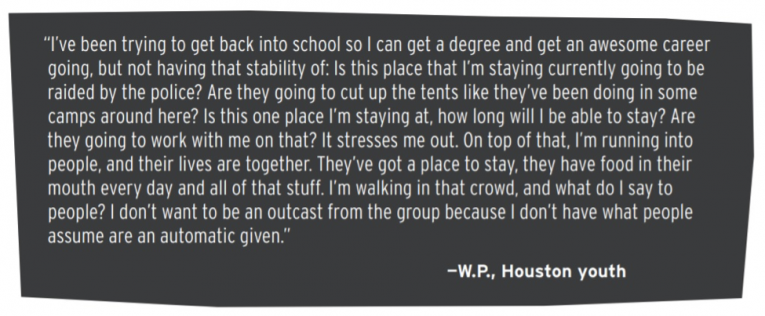Getting an Education When You’re a Kid Experiencing Homelessness

Social media feeds are filling up this week with annual back-to-school photos — kids excitedly posing with their backpacks, brand new sneakers, and school outfits in front of their houses before they head off to school. These adorable photos remind us that summer is over and school is back in session. It’s also an important reminder that for children in Texas experiencing homelessness, school is often a place of refuge, providing meals and shelter, as they struggle to otherwise meet their basic needs.
Many youth experiencing homelessness try to remain invisible for a number of reasons, including fears around their safety, being placed in Texas’ foster care system, and stigma accompanying the label of homelessness. And while it is hard to determine how many kids are experiencing homelessness in Texas given challenges with identification and kids’ invisibility, we do know more than 116,000 students experienced homelessness at some point throughout the 2016-2017 school year.
We also know that living situations vary. For example, let’s think about three hypothetical students who represent common experiences of some Texas students:
Amanda, 15, has spent the last few weeks sleeping on the couch at a friend’s house. Before that, Amanda spent a couple nights in a tent. Her mother doesn’t know where she is, but she hasn’t spent a lot of time looking for her and hasn’t reported her missing, even though she’s been gone for a month.
Jason, 16, has been living in a motel for the past two months after running from an abusive home. He has enough money to last him for two more weeks in the motel, but he’s not sure what his living situation is going to be like after his summer job ends.
Victoria, 17, slept in her car last night and will sleep in her car tomorrow night and likely the night after that. She’s been using a local youth drop-in center to shower and wash her clothes.
When Amanda, Jason, and Victoria all walked into their local Texas high school registrar’s office to ensure that they were registered for school, the registrar was not sure what to do with each of them without a parent present. What should the registrar do?
While the school registrar may have other obligations under the law with regards to unaccompanied youth (school personnel are mandatory reporters for the purposes of child welfare laws), the registrar is also required to immediately enroll all youth — with or without parental consent and with or without any of the normal documentation — who are in these types of situations.
Under the McKinney-Vento Homeless Education Assistance Improvements Act of 2001 (the “McKinney-Vento Act”), as reauthorized by the Every Student Succeeds Act (“ESSA”), all three of the situations we mentioned earlier describe students who are considered “homeless.” Amanda is couch-surfing, if Jason didn’t have the motel he would have no other place to be, and Victoria is living in her car. These are all examples of unstable living places.
Understanding that education is critical to helping youth out of homelessness and preventing them from experiencing homelessness as adults, Congress saw fit to ensure that youth experiencing homelessness would have the support they need to succeed. In fact, every school district in the country is required to appoint a homeless liaison who must, among other things:
- Work to identify youth experiencing homelessness;
- Ensure that youth experiencing homelessness are immediately enrolled, even without the usual documentation needed for enrollment;
- Make certain they receive any additional educational services for which they are eligible, including pre-school and special education services;
- Provide transportation to the student’s school, including their school of origin;
- Furnish referrals to health care, housing, and other appropriate services;
- Post public notice of their education rights; and
- Train other school personnel on issues of youth homelessness.
As students go back to school this fall, it is essential that students and school personnel know their rights and responsibilities with regard to students who may be experiencing homelessness at any time throughout the school year. For more information, students, parents, teachers, administrators, shelter staff, service providers, and homeless liaisons should visit www.homelessyouth.org/us/texas and www.theotx.org.


